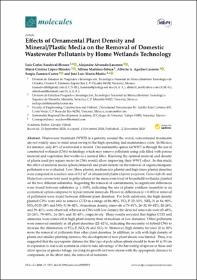Mostrar el registro sencillo del ítem
Effects of ornamental plant density and mineral/plastic media on the removal of domestic wasteater pollutants by home wetlands technology
| dc.contributor.author | Sandoval Herazo, Luis Carlos | |
| dc.contributor.author | Alvarado Lassman, Alejandro | |
| dc.contributor.author | López Méndez, María Cristina | |
| dc.contributor.author | Martínez Sibaja, Albino | |
| dc.contributor.author | Aguilar Lasserre, Alberto Alfonso | |
| dc.contributor.author | Zamora Castro, Sergio | |
| dc.contributor.author | Marín Muñiz, José Luis | |
| dc.date.accessioned | 2022-06-28T03:47:20Z | |
| dc.date.available | 2022-06-28T03:47:20Z | |
| dc.date.issued | 2020-11-12 | |
| dc.identifier.other | 10.3390/molecules25225273 | |
| dc.identifier.uri | http://repositorios.orizaba.tecnm.mx:8080/xmlui/handle/123456789/560 | |
| dc.description.abstract | Wastewater treatment (WWT) is a priority around the world; conventional treatments are not widely used in rural areas owing to the high operating and maintenance costs. In Mexico, for instance, only 40% of wastewater is treated. One sustainable option for WWT is through the use of constructed wetlands (CWs) technology, which may remove pollutants using cells filled with porous material and vegetation that works as a natural filter. Knowing the optimal material and density of plants used per square meter in CWs would allow improving their WWT effect. In this study, the effect of material media (plastic/mineral) and plant density on the removal of organic/inorganic pollutants was evaluated. Low (three plants), medium (six plants) and high (nine plants) densities were compared in a surface area of 0.3 m2 of ornamental plants (Alpinia purpurata, Canna hybrids and Hedychium coronarium) used in polycultures at the mesocosm level of household wetlands, planted on the two different substrates. Regarding the removal of contaminants, no significant differences were found between substrates (p ≥ 0.05), indicating the use of plastic residues (reusable) is an economical option compared to typical mineral materials. However, differences (p = 0.001) in removal of pollutants were found between different plant densities. For both substrates, the high density planted CWs were able to remove COD in a range of 86–90%, PO4-P 22–33%, NH4-N in 84–90%, NO3-N 25–28% and NO2-N 38–42%. At medium density, removals of 79–81%, 26–32, 80–82%, 24–26%, and 39–41%, were observed, whereas in CWs with low density, the detected removals were 65–68%, 20–26%, 79–80%, 24–26% and 31–40%, respectively. These results revealed that higher COD and ammonia were removed at high plant density than at medium or low densities. Other pollutants were removed similarly in all plant densities (22–42%), indicating the necessity of hybrid CWs to increase the elimination of PO4-P, NO3-N and NO2-N. Moreover, high density favored 10 to 20%more the removal of pollutants than other plant densities. In addition, in cells with high density of plants and smaller planting distance, the development of new plant shoots was limited. Thus, it is suggested that the appropriate distance for this type of polyculture plants should be from 40 to 50 cm in expansion to real-scale systems in order to take advantage of the harvesting of species in these and allow species of greater foliage, favoring its growth and new shoots with the appropriate distance to compensate, in the short time, the removal of nutrients. | es |
| dc.language.iso | en | es |
| dc.publisher | MDPI | es |
| dc.subject | Wetlands | es |
| dc.subject | wastewater | es |
| dc.subject | pollutants | es |
| dc.title | Effects of ornamental plant density and mineral/plastic media on the removal of domestic wasteater pollutants by home wetlands technology | es |
| dc.type | Article | es |
Ficheros en el ítem
Este ítem aparece en la(s) siguiente(s) colección(ones)
-
Artículos (DCI) [72]



